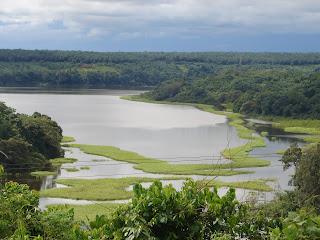

In all my 17 years experience making field trips as a journalist, never before had I been so excited and anxious to visit a conservation area. Maybe I was a little too nervous and scared about the prospect of mingling with big rivers, creeks and the high sea. During the two hour bus drive from Cameroon’s capital, Yaoundé to Edea, I could not stop imagining how it would be out there in the Douala – Edea Reserve: the place where many of Cameroon’s biggest rivers converge as they end their journey of hundreds of kilometres from the north to the south into the Atlantic Ocean.
My anxiety dampened as the 70-seater bus dropped me off at Edea as it continued its journey to Cameroon’s economic and most populous city of Douala. I had arrived Edea at the peak of an October torrential down pour. The colonial town of about 100.000 people seem to be at a standstill under the deluge as I took refuge at a fuel pumping station. The rain battered on even harder.
Edea, the colonial town
Visiting the Douala – Edea Reserve can be a real rough experience if you don’t have a car of your own. Few vehicles ply the about 60 kilometres earth road that leads to the small town of Mouanko - the administrative seat of the reserve. The few available vehicles – the “clandos” offer extremely difficult travelling conditions. Apart from the rugged state of the pick-up clandos, you may find yourself seating on someone’s lap like a child or being seated upon, that is, if you are not standing on your feet and clinging tightly to whatever.
I was lucky to have made travelling arrangements with the Cameroon Wildlife Conservation Society, CWCS; one of Cameroon’s leading conservation organisations based and also operating in the Reserve. As I sat waiting for the CWCS vehicle, I had time to see Edea more closely, especially after the rain subsided.
Edea is less than an hour’s drive from the Douala International Airport. A conservative town, one would say. Most of the structures dating from the German colonial period over a hundred years ago still stand, though dilapidating. Notable among these is the once magnificent German bridge over the River Sanaga. Edea is host to one of the most important of Cameroon’s hydro electricity dams. The country’s main aluminium company as well as agro and timber industries make the town attractive to job seekers from other parts of Cameroon and beyond. Like many towns in Cameroon, hundreds of motorbikes swamp around, playing as taxis. There are visibly more bikes than cars.
Edea is one of those areas that depict Cameroon’s economic doldrums of the 90s. Most companies either folded up or rendered thousands redundant in restructuring attempts. Most of those who lost their jobs have since gone to rural areas either to roast or to search for greener pastures. One of such areas that experienced an influx is the small town of Mouanko and its environs.
No comments:
Post a Comment